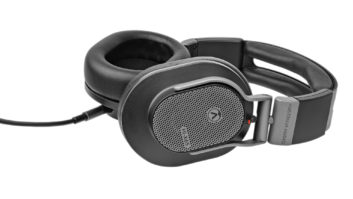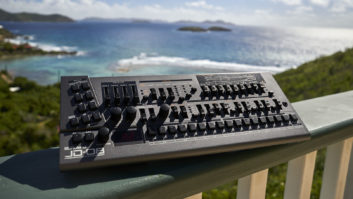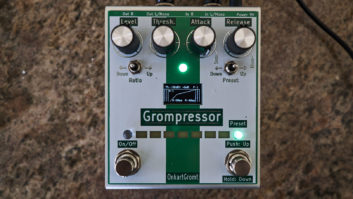I’m still a fan of the classic AKG K240s, with their open-backed design and rather open sound as well, but the AKG K275 and AKG K371 headphones reviewed here are closed-back and more in line with modern performers/recordists who like the tight isolation, extended bass and high SPLs of closed-backs.
K275
The K275s offer a round, closed-back, over-ear design and slow-retention foam ear pads. They don’t look like it, but they fold right up for easier transport, with a three-axis hinge and rotatable cups, and they come with a nice cinch-top storage bag. At 295 grams (0.65 pounds), these AKG headphones are slightly heavy in use, but still comfortable because of the soft ear pads. These headphones will only go so small, however, as the headband tension defines fit, so smaller people and those with bald heads might want to try them on before purchase.
The large 50 mm drivers operate at a low-ish 32 ohms, enabling efficient use with a 109 dB SPL/V rating and wide response from 16 Hz to 28 kHz. Sonically, I found the 275s to have a warm high end, with more of a bottom end emphasis and plenty of low-mids, not the carved out middle that is so common. The low end isn’t terribly defined, so I had trouble making mix decisions, but I found that performers liked tracking through them quite a bit. Bassists and guitarists appreciated the full, warm response, even if they weren’t such a hit with vocalists.
The stereo imaging was strong, with a well-defined phantom center, and dynamics were slightly constrained at higher volumes (like most headphones). Although I wasn’t able to mix on the 275s solely, I did find them a useful mix check for excessive low-mids and to make sure that higher-pitched elements were well represented.
The two big steel bands that are the backbone of the 275s seemed amply strong and durable, and the three cables provided (coiled, short straight, and long straight) are connected via a nice LEMO connector, ensuring long life and durability.
K371
Even though the 371s are foldable, over-the-ear and closed-back, they’re really nothing like the 275s. Here, the ear cups are oval, with a softer slow-retention foam, and their lighter 255-gram weight (0.56 pounds) makes for a comfier fit. These cans have ear cups on sliding bands, unlike the sliding headband of the 275s, which allows for a snugger fit. Plus, they still fold up (the ear cups and their support arms snap and fold inward).
Once again, we’ve got 50 mm drivers, but this time with pure oxygen-free voice coils (and the accuracy that reportedly brings). These phones have 32 ohms impedance but yield a very efficient 114 dB SPL/V, with an extremely wide frequency response of 5 Hz to 40 kHz.
The K371’s sonic signature is decidedly different from the 275, with a tighter and more defined low-end response, more punch, still a warm top end, and upper-mids that are much more forward. Dynamics and imaging seem comparable to the 275s and sufficient.
I found performers liking these AKG headphones, too, with instrumentalists and vocalists enjoying them, but bassists not so much (nor myself when mixing). As much as I loved the comfort and fit of these phones (I can wear them for hours without fatigue), I never could get over one prominent midrange frequency bump (600-ish) that got in the way of my mix decisions. This response made vocal and upper instrument decisions tough, but I still found the 371s to be a great bottom-end reference checkpoint. Their nicely moderated bass response is well distributed and quite even across the spectrum, providing great insight to bass and drum mix decisions.
The three cables and storage bag complement the 371s as well, making them a good choice for users who wear headphones for very long periods of time, who want effective isolation and comfort, and those who like their guitars/vocals/snares more prominent than their kicks/basses/toms.
AKG • www.akg.com







